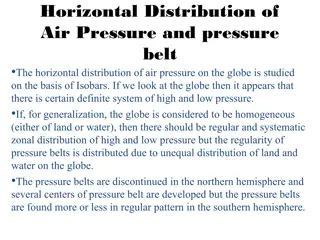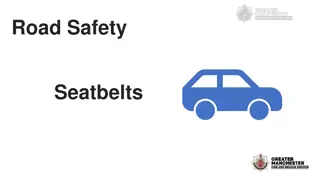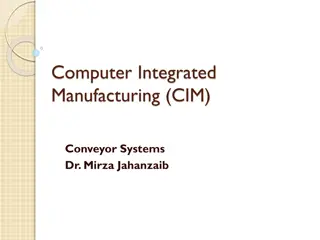Efficient Belt Patch Detection System for Conveyor Belts in NTPC Ramagundam
This project focuses on the in-house development of a belt patch opening detection system for conveyor belts at NTPC Ramagundam. The system aims to address the common problem of belt patch openings in Coal Handling Plants, improving maintenance efficiency and reducing downtime associated with belt replacements. By utilizing innovative design, fabrication, and programming, the team has created a solution to timely detect and rectify belt patch issues, ultimately optimizing the conveyor belt system's performance.
Download Presentation

Please find below an Image/Link to download the presentation.
The content on the website is provided AS IS for your information and personal use only. It may not be sold, licensed, or shared on other websites without obtaining consent from the author.If you encounter any issues during the download, it is possible that the publisher has removed the file from their server.
You are allowed to download the files provided on this website for personal or commercial use, subject to the condition that they are used lawfully. All files are the property of their respective owners.
The content on the website is provided AS IS for your information and personal use only. It may not be sold, licensed, or shared on other websites without obtaining consent from the author.
E N D
Presentation Transcript
IPS 2024 RAMAGUNDAM
IN-HOUSE DEVELOPMENT (DESIGN, FABRICATION & PROGRAMMING) OF BELT PATCH OPEN DETECTION SYSTEM FOR CONVEYOR BELTS IN NTPC RAMAGUNDAM. 1) Atul Krishna Gaikwad 2) Ratan Kumar Gulipilli 3) Devendra Patil
Introduction Coal Handling Plant (CHP) of RSTPS uses fabric conveyor belts for transporting coal. Fabric conveyor belts are made by sandwiching many synthetic fabric layers between rubber layer through adhesive rubber called skim rubber. Conveyor belts come in typically 200/250 meters length rolls. Belts are mainly joined through cold/hot vulcanizing method to achieve required length and to complete the loop. In conveyor system belt joint are the weakest part and prone to damage. It contributes to highest inventory of CHP. 3
Introduction of Problem Belt patch opening is a common and serious problem in CHP. Presently this problem is detected by location workers in initial level and get attended. If this problem, go unnoticed and belt patch stuck up in nip points and joint opened beyond repair then this led to high restoring time of system and may further lead to generation loss. Planned belt replacement works takes almost 12 hrs. and Unplanned belt replacement work takes more than 24hrs. Hence timely detection of belt patch is the need of hour. 4
Breakdown Analysis Chart Title 892 900 800 700 544 600 397 500 357 400 300 182 119 200 100 0 RAMAGUNDAM SIMHADRI KUDGI Data from 01.01.2020 to 31.12.2022 Total Belt Patches in 3 Years Belt Patches Per Year 5
FISH BONE DIAGRAM ANALYSIS MACHINE ONE SIDE FEEDING Water/dust ingress Damaged Blade MAN COAL BUILD UP Roof sheet DEFLECTOR DAMAGED Improper Scraper/skirt rubber Over tensioned Poor IMPROPER CHUTE DESIGN HOUSE KEEPING LACK O F KNOWLEDGE Adhesion/Solution BELT SWAY TAKE UP MISALIGNMENT CARRYING FRAME MISALIGNMENT IMPROPER POSITION STRINGER MISALIGNMENT Improper Belt Joint PILE HEIGHT IS HIGH Coal build up LACK OF KNOWLEDGE BELT TENSION DAMAGED FRAMES LACK OF SKILL IMPROPER FEEDING BOOM AT MAX HEIGHT CONV STRUCTURE MISALIGNMENT BELT SLIP Old belt IDLERS ROLLERS JAM IMPROPER CLEANING OF CHUTED LACK O F KNOWLEDGE LACK OF SKILL LACK OF KNOWLEDGE ROLLER SHELL DAMAGE Belt Joint Patch open/Belt joint damage LOAD ON BELT ZERO SPEED SWITCH FAULT OVER LOADING SLURRY COAL PROBE DAMAGE INTERLOCK FAILURE COAL QUALITY SUPPLY FAILURE WET COAL BOULDRES CONTROL SUPPLY /PLC FAILURE SCREEN DAMAGE POOR TRIP CIRCUIT FAILURE MAINTENANCE IMPROPER CRUSHING MATERIAL 6 6 PROTECTIONS& INTERLOCKS
Fish Bone Diagram Analysis Through fish bone diagram analysis and rigorous brainstorming sessions we have conclude that there are many reasons that lead to belt patch open/damage issues. We have categorised causes into Man, Machine, Material & Protection Interlocks categories. We have observed that belt joint gets opened or damaged mainly due to Poor housekeeping, Belt sway, Improper feeding, Improper scraper, water and dust ingress into the joints, wet coal handling or chute chocking etc. Through root cause analysis, we came to deduction that we can minimize the chances of belt patch opening through best operation & maintenance practices but cannot eliminate the problem totally. 7
Solution We have surveyed in market for solutions which are suitable for the fabric conveyor belts but did not find suitable solution. After intense brainstorming we have come to the following conclusions:- a) We can increase the deployment of manpower for continuous observation of all belts. b) To develop a system for automatic detection of belt patch opening. The cost of deployment of manpower is very high and they are always prone to human errors. Hence, we decided to develop a system to identify belt patch opening automatically at the initial stage. 8
Action We observed several behaviors of opened belt patches during running of conveyor belts and keenly studied them and identified that opened belt patches while coming to the return side of the conveyor belt, the patch or layer of the belt hits along the return idlers with some intensity. Hence, we decided to use this force of the running belt patch to develop a system to detect it. We have discussed the use of many sensors like force sensors but due to many restrictions like patch location, size of the patch, we zeroed the use of tilt sensor. Hence, we decided to design a mechanical system which will operate with the hitting of opened belt patch and activate tilt sensor. 9
Mechanism We experimented with the flap mechanism wherein the flap gets operated while it is hit by belt patch and operates a tilt sensor connected to a flap. BELT PATCH The tilt sensor measures the angle of tilt, and this angle is measured by Arduino. ALARM/SIREN FLAP The Arduino activates the alarm after processing the tilt senor data and activates the alarm. The alarm is a local siren which gets activated when the flap gets hit by the patch. ARDUINO SENSOR 10
Proof of Concept (POC) FLAP Locking Mechanism Tilt Sensor CPU UNIT Counter Weight 11
Cost Benefit Analysis Cost of Belt patch detection System: Cost of manufacturing and supply of BPDS= Rs 25000.00/unit A) Total cost for all conveyor= 67 nos. belts* 25000.00=Rs 1675000.00 B) Cost of power and control cable= Rs. 1800000.00 Cost of installation= Rs. 3000/unit C) Total cost of installation= 67*3000= Rs. 201000.00 Hence total cost for Purchase & Installation of BPDS in 67 belts of CHP Ramagundam = A+B+C=1675000+1800000+201000= Rs. 36.76 Lakh 13
Cost Benefit Analysis Financial impact of problem: 1. As per past data & experience there is an average 200 mtr approx. belt gets damaged every year due to belt patch opening if not detected timely. A. Cost of 200 mtr conveyor belt= INR 1099400.00 (average price of conv belt Rs. 5497 per mtr). B. Cost of replacement of conveyor belt= 186.50 X 200 + 4 (2 joints, 2 occasion) X 23127 = 37300 + 92508 = Rs. 129808 C. Total financial impact of problem per year = Rs. 1229208 Pay Back Period= 3676000/1229208= 2.99 years *Note Reduction of maintenance cost is the added advantage. This saving can also be incurred in all other NTPC plants. 14
Intangible benefits Stress on Location workers will be reduced. Stress on Control room executive will be reduced as they will be able to identify problem at early stage and shut down of system will not be required for longer period. Stress on maintenance workers and executives will be reduced due to lesser unplanned belt work. 15
Conclusion It is said that the Coal Handling Plant is the heart of coal-based power plant which feeds coal to the bunkers for power generation, then conveyor belts are indeed the veins of system. Any major breakdown in conveying belt may lead to generation loss. Belt joint patch/layer opening problem is very common in CHP but this small problem may damage belt beyond repair if not detected timely. We felt the requirement of a product that could detect belt patch opening in initial stage and alarm the control room for its occurrence. Hence, we developed a product called belt patch open detection system in-house which can detect opened belt patch at the initial stage and can raise alarm. This idea/product was selected in NTPC Innovation scheme and now we are developing a market ready prototype with the help of NTPC NETRA. 16























